Cool Season Gardening
Air Date: Week of October 28, 2022
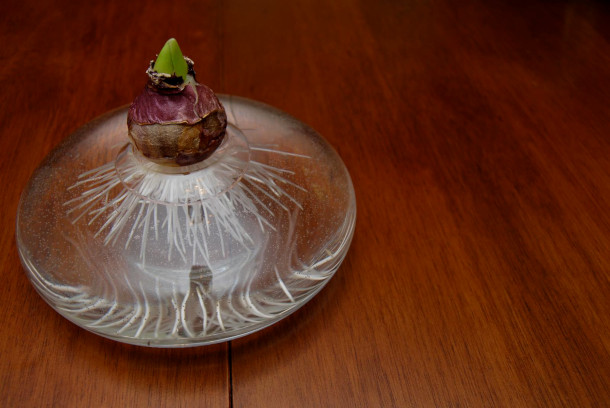
Forcing hyacinths in a glass in water. Hyacinths come in a range of colors including lilacs, pinks, white, cobalt blue, cream. (Photo: Christina B Castro, Flickr, CC BY NC 2.0)
For gardeners based in the northern hemisphere, fall is the time to clean up garden beds and prepare for the winter snow. But the joys of gardening don’t have to hibernate until spring. Living on Earth gardening guru and former host of the Victory Garden on PBS, Michael Weishan, joins Host Bobby Bascomb to discuss tips for extending the growing season, including forcing bulbs indoors.
Transcript
BASCOMB: In the northern Hemisphere the days are getting shorter and for many gardeners that means it’s time to clean up garden beds and get ready for winter. But gardening doesn’t have to end when the snow falls. So, we turn to Living on Earth’s Gardening Guru, Michael Weishan. He’s the former host of the Victory Garden on PBS and has some tips for extending the growing season, including forcing bulbs. That’s a way of bringing flowering bulbs inside to trick them into blooming out of season, something gardeners can do in any part of the country. Michael, welcome back to Living on Earth.
WEISHAN: Hi, I'm delighted to be back.
BASCOMB: Well, you know, frost and winter is just around the corner. What should people be doing right now to prepare their gardens for the winter that's coming?
WEISHAN: Well, you know, in the gardening world, it's pretty set by now the you know, the garden year is essentially over. So you know, you let things be frosted out, you bring your house plants in. If you have still house plants out, time to bring them in. I start looking forward to the things for the winter, among them, for instance, forcing spring bulbs. It's time to order bulbs now, if you haven't already, both for planting outdoors and for forcing indoors. It's time to look around and assess really what worked well in your garden this year, and what didn't. And if it's been a multiple year failure, it's probably time to make some other choices. And that's hard sometimes for people to do they, you know, they keep trying to do the same thing and it's like, it's not working, it's not working. It's like, okay, if you've tried three times growing this and it hasn't grown time to find something else, because there's probably some problem and it's probably not you.
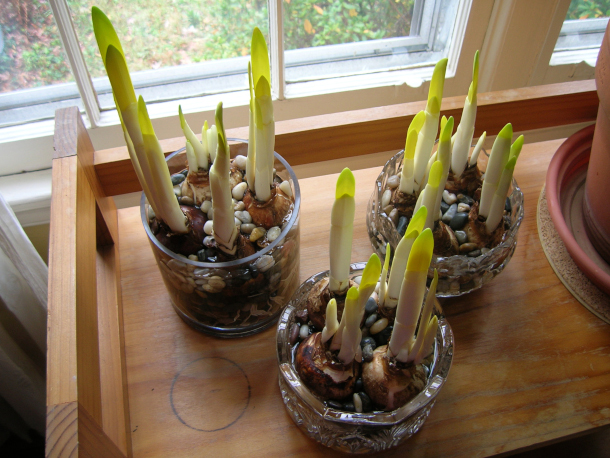
Paperwhites are a great option to force in water or in a pot with soil, though they can’t be planted outside afterwards in cold climates. Using water is the simplest option: Stick bulbs part-ways into clean gravel, glass beads, or other loose material in which roots will grow and intertwine to support the top-heavy growing plants so they don't tip over. (Photo: Margaret Price, Flickr, CC BY NC 2.0)
BASCOMB: Yeah, I'm about to give up on carrots really.
WEISHAN: I yeah, I've grown carrots. It's just a carrots are really cheap to buy and new carrots, especially you buy them at the farmers market or whatever they all tastes really great. So I don't see the value in actually growing carrots. They're very hard to grow, they have to be weeded constantly, you know, the soil has to be perfect, or they all turn into little knobbies. I put my garden energy elsewhere in leeks, for instance, which are expensive, expensive, and here grow just absolutely beautifully, so love them.
BASCOMB: Well, there's a lot of reason to that. But I don't want to be outdone by a carrot, you know?
WEISHAN: I don't know, nature always wins.
BASCOMB: [LAUGH]
WEISHAN: So I suggest graceful surrender and moving on to you know, to what you do best. You know, some of the things that for instance, the dahlias did really beautifully this year, as did the the flowers. They loved all the heat. And the tomatoes did not do so fantastically, late blight and a few other things. So what can I say, you know, you're given whatever you get and you are thankful for that and say "thank you, thank you very much".
BASCOMB: Yeah. And it's not just about what you get out of the garden. I always think you know, it's the experience that you've had of being outside and observing nature. And there's so much more to it than just you know, picking a salad for dinner.
WEISHAN: Well, I will honestly say that this summer, there was no real outside to it. [LAUGH] It was, we had one of the hottest summers we've ever had on record and it was consistently in the high 90s every single day with high humidities. That being said, there were a lot of things that did very well squashes, for instance, I love all that heat. The beans did all very well. So it really was kind of running out either early morning or late in the evening, you know, grabbing what you can, before you turned into a giant ball sweat and then running back inside.
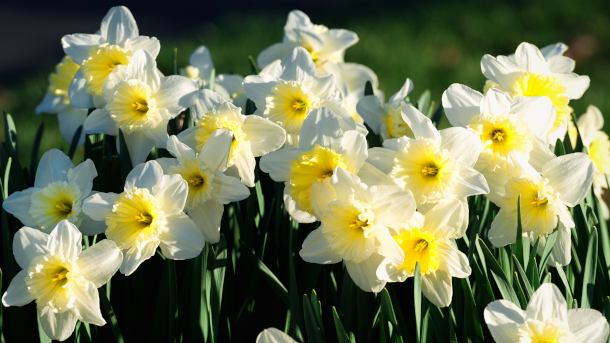
After the winter is over and frost has disappeared, forced bulbs can be planted outside
and they’ll flower every spring for years to come, like the daffodils pictured above. (Photo: Bill Dickinson, Flickr, CC BY NC ND 2.0)
BASCOMB: Yeah, well, climate change is real. Yeah, many, many days in the high 90s in New England is just not typical for us.
WEISHAN: No, and it's very hard on the plants. You know, one of the things that people don't realize is that when plants overheat unless they're a certain type of plant with a certain type of photosynthesis structure with a certain type of number of carbon atoms, they shut down, essentially photosynthesis just shuts down. So it can literally get just like a person on a hot parking lot, you're not going to be doing push ups or anything, if you're just going to be trying to sit there and be as cool as possible and the plants are the same way. So when you get very long stretches of high temperatures, and then more critically no cool off at night because that's their recuperation period, when the night stay above 70 degrees for instance, here we're in trouble. And that was the way it went for weeks and weeks on end. So essentially everything just was in stasis, you know suffering through, suffering through the heat. But you get to the flip end of that, the heat, and you then you get a wonderful fall season. So the beans have now recovered and the flowers are all going strong, the raspberries where bursting all the way through. Again, if you value your time in the garden, and if you value the beauty of being outdoors, whatever you get is a bonus, you know in the process.
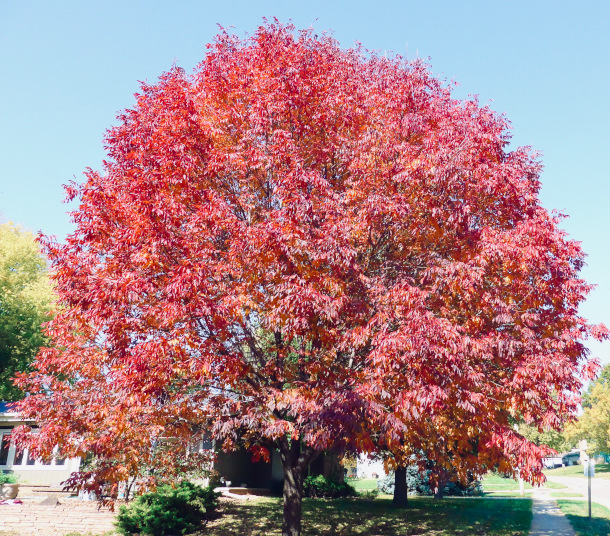
A beautiful ash tree showing its red foliage during autumn. Ash trees have been part of the North American and European landscape for thousands of years, but are now under threat due to invasive pests and pathogens like the emerald ash borer. (Photo: Ali Eminov, Flickr, CC BY NC 2.0)
BASCOMB: Yeah, that's so true. Well, it's finally cooling off now. What are you thinking about right now to get through the long winter without your garden?
WEISHAN: Well, I retreat to my greenhouse, which is not something a lot of people are able to do. But that being said, I also force a lot of bulbs and bring them indoors for the winter season. And some things that people don't generally think about like freesia, which is a South African bulb originally, forces beautifully. A little tricky to get started but needs some cool temperatures and then off it goes into the house. But I have learned a technique that I have learned from one of the British gardening shows, using your forced bulbs as your bulbs for this year and then planting them outside at the end of the spring and planting them into your garden. So that the only bulbs I now order are bulbs, I actually plan to force. And then at the end of the forcing time we put them aside, they can go into a basement or unused shed or whatever. And then early in the spring, they can be planted out after they finish blooming and the frosts are done. And then they'll recover and be in the garden for next year. So you don't throw away then all these beautiful bulbs. I always have a problem with that I love paperwhites, for instance, they're not hardy to hear, you can't plant paperwhites outside. So all that energy and carbon costs and everything that went into producing those bulbs, and it's extensive. I mean, they're all grown in Holland, and then flown here and gigantic 747s and then distributed by trucks all the way across the United States. So there's huge carbon costs and all this. And it just seems a shame to have put all that energy to waste and then simply throw it away. So I don't force paperwhites anymore. I generally choose small varieties of daffodils, crocus's, small iris reticulata, a lot of the small bulbs, they all forced beautifully, hyacinth, and things that then can be reused back into the garden. And ever since I started this process, I feel A much better about it and it also saves a ton of money because otherwise you're buying twice, right? You're buying for inside and outside and throwing away the inside, which is bonkers. So it's a wonderful opportunity. There's some tricks to it, though. And I think you know, one of the things if you're thinking about doing this is that you have to realize that bulbs need a cold period of rest, after they've been planted in the pots. They need to go into dormancy, and they have to be in temperatures of about 40 degrees for six to eight weeks. So if you're living in the South, you actually have to stick your bulbs into the refrigerator, or you buy them pre-chilled, which is another way to do it. But in the north, you plant them right about now. And you can leave the pots outside or so at Christmas or so and then bring them in into a basement or something and then bring them upstairs slowly as you wish to enjoy them. And you can stagger them out over all of January and February and sometimes even into March.
BASCOMB: So now is the time to think ahead to the winter and forcing bulbs. What else are you thinking of in terms of planning for the future? You know, both for the spring? And I don't know, years to come?
WEISHAN: Well, you know, one of the things is now time to reevaluate if what has worked and what has not worked in your garden. And also what is on its way out. I've had the death of a friend here this week. My ash tree that was behind my house. One of the reasons I bought it 30 years ago, huge. It was larger than the house was 100 years old, and has succumbed to the imported Irish ash borer. So it had to be cut down.
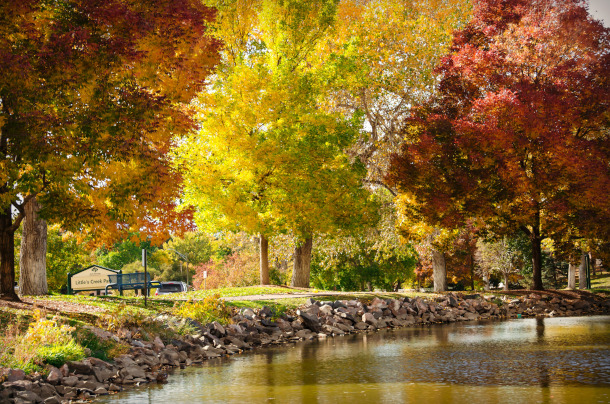
The White Ash tree (left and right) has green, red, orange, and yellow leaves all at the same time, to create a stunning display. The Golden Ash tree (middle) turns a gorgeous shade of bright yellow. (Photo: Cathy McCray, Flickr, CC BY NC ND 2.0)
BASCOMB: Yeah, it's too common and too sad. That's happening a lot in the region.
WEISHAN: Yeah, between that and the Ash decline. Ash were a major part of the New England forests, and now they are not. And this thing was huge. Well I'll tell you how big it was. It's now a stump and the stump is six foot in diameter, so...
BASCOMB: Wow.
WEISHAN: Yeah, I mean, a huge, huge tree. And it shaded the house beautifully in the summer and protected it and also protected all the gardens that are underneath it, which are shade gardens. Well, guess what, they're not gardens anymore. [LAUGH] You know, the house is now exposed to, the whole back of the kitchen area is now exposed to full sun. So there's gonna have to be some rethinking in terms of how that goes. I did start a replacement tree a number of years ago, one of the Princeton elms, which is supposedly resistant to Dutch elm disease, and is fairly rapidly going. But I will never see a tree in that space, and anywhere the equivalent of the tree that that came down. But I think that, you know, people need to think about the sort of longevity of some of the plants in their garden and how gardens have changed and will change over the course of time. One of the things you know, one of the great adages in gardening is, if you're a good gardener, you will ultimately become a shade gardener. Because the things that you've planted will grow large and shade out the you know, the things beneath. So you start with a plan that is set for full sun, for instance and over the course of years, five years, ten years, things change. And I think a lot of times people don't change with them. And a lot of times poor planning is the cause of it. And sometimes even you know garden designers like myself poorly plan things. I planted a huge beech tree in what was then a pasture 30 years ago thinking I wanted a shade tree in the pasture. Well ultimately, my main garden space moved there. And as the tree has grown my main garden space a vegetable garden space is now being shaded by this gigantic beech tree. And I think to myself, oh, if I had just thought about potential uses for this, I would have moved it 30 feet over in the other direction. So I think it's really important to think about, you know, how things grow and how things mature. And Fall is a great time to do that. Because you can look around you see the bare spots in your yard, and you seat- wow, okay, next year, we're going to do something about this. So it's a time to think ahead, and also to think back and say, wow, I did a pretty good job [LAUGH] on some of this anyway.
BASCOMB: Michael Weishan is a master gardener. He's been hosted the Victory Garden on PBS and a regular gardening guru here on living on Earth. Michael, thanks again for your time today. It's been really fun chatting with you.
WEISHAN: As always, Bobby, thank you.
Links
Learn more about Michael Weishan
Living on Earth wants to hear from you!
Living on Earth
62 Calef Highway, Suite 212
Lee, NH 03861
Telephone: 617-287-4121
E-mail: comments@loe.org
Newsletter [Click here]
Donate to Living on Earth!
Living on Earth is an independent media program and relies entirely on contributions from listeners and institutions supporting public service. Please donate now to preserve an independent environmental voice.
NewsletterLiving on Earth offers a weekly delivery of the show's rundown to your mailbox. Sign up for our newsletter today!
 Sailors For The Sea: Be the change you want to sea.
Sailors For The Sea: Be the change you want to sea.
 The Grantham Foundation for the Protection of the Environment: Committed to protecting and improving the health of the global environment.
The Grantham Foundation for the Protection of the Environment: Committed to protecting and improving the health of the global environment.
 Contribute to Living on Earth and receive, as our gift to you, an archival print of one of Mark Seth Lender's extraordinary wildlife photographs. Follow the link to see Mark's current collection of photographs.
Contribute to Living on Earth and receive, as our gift to you, an archival print of one of Mark Seth Lender's extraordinary wildlife photographs. Follow the link to see Mark's current collection of photographs.
 Buy a signed copy of Mark Seth Lender's book Smeagull the Seagull & support Living on Earth
Buy a signed copy of Mark Seth Lender's book Smeagull the Seagull & support Living on Earth

